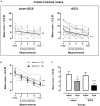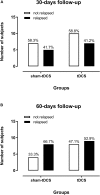Lack of Effects of Extended Sessions of Transcranial Direct Current Stimulation (tDCS) Over Dorsolateral Prefrontal Cortex on Craving and Relapses in Crack-Cocaine Users
- PMID: 30405414
- PMCID: PMC6206545
- DOI: 10.3389/fphar.2018.01198
Lack of Effects of Extended Sessions of Transcranial Direct Current Stimulation (tDCS) Over Dorsolateral Prefrontal Cortex on Craving and Relapses in Crack-Cocaine Users
Abstract
Background: Non-invasive brain stimulation such as transcranial direct current stimulation (tDCS) has been investigated as additional therapeutic tool for drug use disorder. In a previous study, we showed that five sessions of tDCS applied bilaterally over the dorsolateral prefrontal cortex (dlPFC) reduced craving to the use of crack-cocaine in inpatients from a specialized clinic. In the present study, we examine if an extended number of sessions of the same intervention would reduce craving even further and affect also relapses to crack-cocaine use. Methods: A randomized, double-blind, sham-controlled, clinical trial with parallel arms was conducted (https://clinicaltrials.gov/ct2/show/NCT02091167). Crack-cocaine patients from two private and one public clinics for treatment of drug use disorder were randomly allocated to two groups: real tDCS (5 cm × 7 cm, 2 mA, for 20 min, cathodal over the left dlPFC and anodal over the right dlPFC, n = 19) and sham-tDCS (n = 16). Real or sham-tDCS was applied once a day, every other day, in a total of 10 sessions. Craving was monitored by a 5-item obsessive compulsive drinking scale once a week (one time before, three times during and once after brain stimulation) over about 5 weeks and relapse was monitored after their discharge from clinics for up to 60 days. Results: Craving scores progressively decreased over five measurements in both sham- and real tDCS groups. Corrected Hedges' within-group (initial and final) effect sizes of craving scores were of 0.77 for the sham-tDCS and of 0.97 for the real tDCS group. The between-groups effect size was of 0.34, in favor of the real tDCS group over sham-tDCS group. Relapse rates were high and quite similar between groups in the 30- and 60-days follow-up after discharge from the hospital. Conclusion: Extended repetitive bilateral tDCS over the dlPFC had no add-on effects over regular treatment when considering craving and relapses to the crack-cocaine use in a sample of crack-cocaine patients with severe use disorder. Different tDCS montages targeting other cortical regions and perhaps additional extension of sessions need to be investigated to reach more efficiency in managing craving and relapses to crack-cocaine use.
Keywords: crack-cocaine use disorder; craving; dorsolateral prefrontal cortex; relapses; tDCS.
Figures




Similar articles
-
Multiple Sessions of Transcranial Direct Current Stimulation (tDCS) Reduced Craving and Relapses for Alcohol Use: A Randomized Placebo-Controlled Trial in Alcohol Use Disorder.Front Pharmacol. 2018 Jul 3;9:716. doi: 10.3389/fphar.2018.00716. eCollection 2018. Front Pharmacol. 2018. PMID: 30018558 Free PMC article.
-
A Randomized Placebo-Controlled Trial of Targeted Prefrontal Cortex Modulation with Bilateral tDCS in Patients with Crack-Cocaine Dependence.Int J Neuropsychopharmacol. 2015 Jun 10;18(12):pyv066. doi: 10.1093/ijnp/pyv066. Int J Neuropsychopharmacol. 2015. PMID: 26065432 Free PMC article. Clinical Trial.
-
Multi-session electrical neuromodulation effects on craving, relapse and cognitive functions in cocaine use disorder: A randomized, sham-controlled tDCS study.Drug Alcohol Depend. 2020 Dec 1;217:108429. doi: 10.1016/j.drugalcdep.2020.108429. Epub 2020 Nov 23. Drug Alcohol Depend. 2020. PMID: 33250383 Clinical Trial.
-
Bilateral transcranial direct current stimulation attenuated symptoms of alcohol use disorder: A systematic review and meta-analysis.Prog Neuropsychopharmacol Biol Psychiatry. 2021 Jun 8;108:110160. doi: 10.1016/j.pnpbp.2020.110160. Epub 2020 Nov 2. Prog Neuropsychopharmacol Biol Psychiatry. 2021. PMID: 33147505
-
Targeting cravings in substance addiction with transcranial direct current stimulation: insights from a meta-analysis of sham-controlled trials.Psychiatry Res. 2024 Jan;331:115621. doi: 10.1016/j.psychres.2023.115621. Epub 2023 Nov 25. Psychiatry Res. 2024. PMID: 38043411
Cited by
-
The Effect of Transcranial Direct Current Stimulation (tDCS) on Cocaine Addiction: A Narrative Review.J Clin Med. 2023 Oct 13;12(20):6511. doi: 10.3390/jcm12206511. J Clin Med. 2023. PMID: 37892650 Free PMC article. Review.
-
Bouncing back: Brain rehabilitation amid opioid and stimulant epidemics.Neuroimage Clin. 2019;24:102068. doi: 10.1016/j.nicl.2019.102068. Epub 2019 Nov 5. Neuroimage Clin. 2019. PMID: 31795056 Free PMC article. Review.
-
Trends of Brain Stimulation Research in Substance Use Disorder: A Review of ClinicalTrials.gov Registered Trials and Their Publications.Indian J Psychol Med. 2024 Dec 9:02537176241300195. doi: 10.1177/02537176241300195. Online ahead of print. Indian J Psychol Med. 2024. PMID: 39677515 Free PMC article. Review.
-
Evidence-Based Guidelines and Secondary Meta-Analysis for the Use of Transcranial Direct Current Stimulation in Neurological and Psychiatric Disorders.Int J Neuropsychopharmacol. 2021 Apr 21;24(4):256-313. doi: 10.1093/ijnp/pyaa051. Int J Neuropsychopharmacol. 2021. PMID: 32710772 Free PMC article.
-
A double-blind sham-controlled phase 1 clinical trial of tDCS of the dorsolateral prefrontal cortex in cocaine inpatients: Craving, sleepiness, and contemplation to change.Eur J Neurosci. 2021 May;53(9):3212-3230. doi: 10.1111/ejn.15172. Epub 2021 Mar 18. Eur J Neurosci. 2021. PMID: 33662163 Free PMC article. Clinical Trial.
References
-
- Anton R. F. (2000). Obsessive-compulsive aspects of craving: development of the obsessive compulsive drinking scale. Addiction 95(Suppl. 2), S211–S217. - PubMed
-
- Batista E. K., Klauss J., Fregni F., Nitsche M. A., Nakamura-Palacios E. M. (2015). A randomized placebo-controlled trial of targeted prefrontal cortex modulation with bilateral tDCS in patients with crack-cocaine dependence. Int. J. Neuropsychopharmacol. 18:yv066. 10.1093/ijnp/pyv066 - DOI - PMC - PubMed
Associated data
LinkOut - more resources
Full Text Sources
Medical

